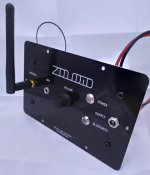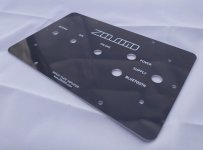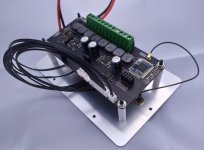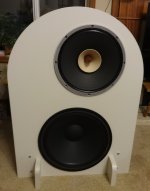!
But this board and the chip on it only supports up to 26,4v.
AFAIK the examples lutkeveld mention regarding voltage vs power output is purely a general academic answer.
Using voltages higher than 26,4v is not supported and may cause damage to the board and/or surrounding components.
That said, lutkeveld, have you tried using higher voltages?
Would be willing to try if you think it might work, just to get a tiny bit more headroom on 8ohm loads.
But this board and the chip on it only supports up to 26,4v.
AFAIK the examples lutkeveld mention regarding voltage vs power output is purely a general academic answer.
Using voltages higher than 26,4v is not supported and may cause damage to the board and/or surrounding components.
That said, lutkeveld, have you tried using higher voltages?
Would be willing to try if you think it might work, just to get a tiny bit more headroom on 8ohm loads.
@KaffiMann,
You can refer to the TAS5825M datasheet to see the absolute maximum ratings.
However, operating at the absolute max instead of the recommend max increase risk of damage significantly and has almost no benefit to the output level.
You are free to try it, but it is not covered by warranty.
@danb11
All orders up to 20 juli ship end of next week. The remaining orders are shipped the end of the week after that.
Other news:
Within 2 weeks a limited amount of front panels will be available:
An easy way to integrate the amplifier into a speaker design as a plate amplifier.
You can refer to the TAS5825M datasheet to see the absolute maximum ratings.
However, operating at the absolute max instead of the recommend max increase risk of damage significantly and has almost no benefit to the output level.
You are free to try it, but it is not covered by warranty.
@danb11
All orders up to 20 juli ship end of next week. The remaining orders are shipped the end of the week after that.
Other news:
Within 2 weeks a limited amount of front panels will be available:
An easy way to integrate the amplifier into a speaker design as a plate amplifier.
Attachments
I tribute the very transparent sound to the Zoudio board.
I gave up all my tube stuff (sold it all on ebay) because of this amp. Trading transparency for all the superlatives of a tube amp, or a tube in the signal path, may have offered.
I too listen at lower SPLs and dont care about compression of loud bass transients - because they never occur - outside of possibly "showing off the stereo" to someone, which is an indefinite impossibility due to COVID... I use very efficient, FR speakers -
I've also been experimenting with other I2S connected "TAS" amplifiers and like the transparency I hear there as well - again on FR speakers. Makes me wonder why all the analog RCA cable connected stuff is such an attraction, other than "that's the way we've always done it". Hated BT at first, but now it's just so easy - no wires, no ground loops - none of the attendant hassles with cabling. I'll look forward to hearing about the TWS subjective performance!
Read the PSRR on such digital input amps isnt as good as the analog counterparts, because you cant do an ordinary global analog feedback from the amps output terminals. So what. Get a good full-analog power supply, which I've done for two such TAS systems. Looks a little funny - huge power tranny, big HS with 3 large pass transistors, cap can the amp could fit inside of. Then the amp itself is this little thing in comparison to the power supply...
No, 50W in 8 ohm is not possible with a 24V PSU.
You need about 32V to get 50W in 8 ohm.
Or you need 4 ohm speakers on 24V.
!
But this board and the chip on it only supports up to 26,4v.
AFAIK the examples lutkeveld mention regarding voltage vs power output is purely a general academic answer.
Using voltages higher than 26,4v is not supported and may cause damage to the board and/or surrounding components.
That said, lutkeveld, have you tried using higher voltages?
Would be willing to try if you think it might work, just to get a tiny bit more headroom on 8ohm loads.
@KaffiMann,
You can refer to the TAS5825M datasheet to see the absolute maximum ratings.
However, operating at the absolute max instead of the recommend max increase risk of damage significantly and has almost no benefit to the output level.
You are free to try it, but it is not covered by warranty.
That was sort of what I wanted to point out.
Anyway, are you still looking into the TAS3251?
I have used this board and find it flexible and easy to setup. One call out is in 2.1 mode it does not use a flow in the chip to permit stereo. Luke has said with enough interest this could be updated in the firmware. I really encourage him to do so to make this a better board. I was a bit disappointed that it didn’t output stereo in 2.1 but I will try two boards using TWS to get stereo on my omnidirectional OTTOPOD speakers.
Planning on using this amp board for a 2.1ch portable bluetooth speaker.
I'd like to use it with a power adapter at home and Li batteries for occasional portability.
Will this be an easy configuration or possible difficulties with this setup?
Has anyone done this?
This is like the primary intended purpose for the Zoudio 4ch. You may be interested in the BMS, makes for a very easy integration.
If you must have stereo 2.2 is an easy solution.
For stereo , and sub , it looks to me like one board is required for each speaker.
Depends what you mean by "sub". I drive a pair of these with just one Zoudio 4 channel amp. That's an 18" assist woofer, handling 100 Hz on down. With reverse rising response to comp for the OB.
They go as loud as I'd ever care to listen, for more than a few moments. At my normal SPL listening levels, the transparency of this amp with these speakers easily exceeds many acoustic instrument recordings. Admittedly, I couldnt put my setup in a dance hall and play uncompressed electronica at 110db...
The Zoudio AIO4CH can be more than a boom-box amp. It depends on what you feed it, what you have it connected to and how you listen; it can serve a fairly large setup. It also happens to be the only full digital signal path right up to the speakers amp I know of, besides some currently available rPi accessories. Which are also in the same <100W / ch power range.
Attachments

Didn't post it in here.. But here is the finished article!
@lutkeveld
A "matrix" mixer mode like miniDSP offers would be the best (and most configurable option) IMO? Each output has the option of L, R or L+R outputs.
Also, still waiting for that missing fundamental synthesiser
- Home
- Vendor's Bazaar
- ZOUDIO AIO4CH: 4-channel amplifier with DSP and Bluetooth



